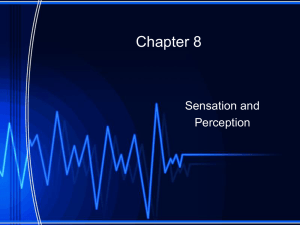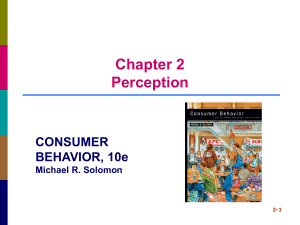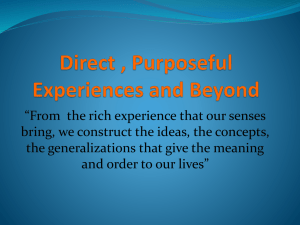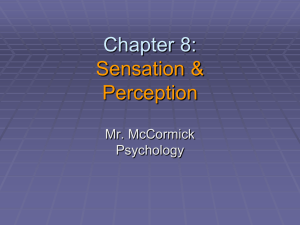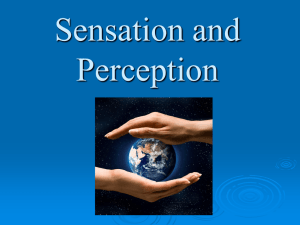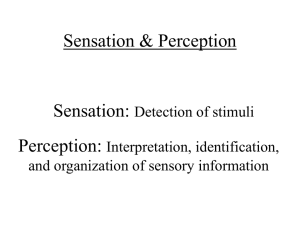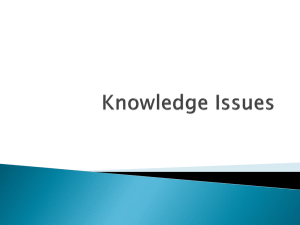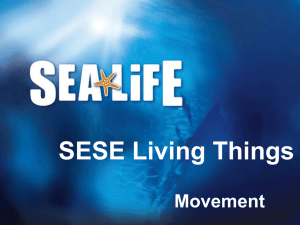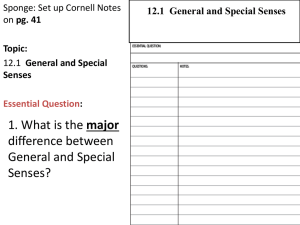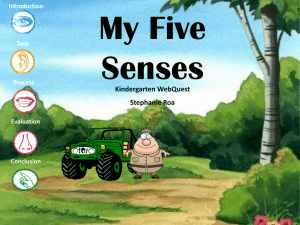Sensory and Perception
advertisement
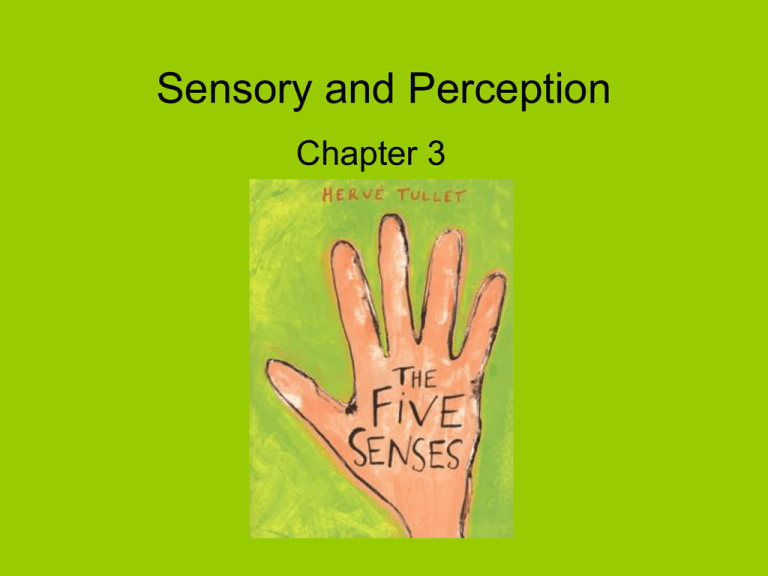
Sensory and Perception Chapter 3 Exploring Psychology Helen Keller had been blind and deaf since she was two years old. For the next four years, Helen was “wild and unruly.” Then when she was six, Anne Sullivan, a teacher, entered her life. Using the sense of touch as the link between their two worlds, Anne tried again and again, by spelling words into Helen’s hand, to make Helen grasp the connections between words and the things they stood for. The breakthrough came one day as Anne spelled the word water into Helen’s hand as water from a spout poured over it. “I stood still, my whole attention fixed upon the motions of her fingers,” Helen remembered. “Suddenly I felt…a thrill of returning thought; and somehow the mystery of language was revealed to me.” adapted from ABC’s of the Human Mind, Reader’s Digest, 1990. Helen Makes a Breakthrough 4:16 The Questions • What senses were unavailable to Helen Keller? • How did she learn to compensate? An Eskimo or Native American? What’s Up? • In the next few seconds, something peculiar will start hap pening to the material youa rereading. Iti soft ennotre alieze howcom plext heproces sof rea ding is. Can You Read This??? • Aoccdrnig to a rscheearch at Cmabrigde Uinervtisy, it deosn’t mttaer in what oredr the ltteers in a word are, the olny iprmoetnt tihng is that the frist and lsat ltteer be at the rghit pclae. The rset can be a toatl mses and you can still raed it wouthit porbelm. This is bcuseae the huamn mnid deos not raed ervey lteter by istlef, but the word as a wlohe. What is sensation? • What occurs when a stimulus activates a receptor. • Stimuli - any change in the environment to which an organism respond. • Stimulus Response What is a perception? • Combined sensations with past experiences. • How we, as INDIVIDUALS, interpret out sensations. • Organization of sensory information into meaningful experiences. Who is this a picture of? Psychophysics • The study of the relationships between sensory experiences and the physical stimuli that caused them. – How much energy is required for someone to hear a sound or see a light? – How much of a scent must be in a room before one can smell it? Absolute Threshold • The point where something becomes noticeable to our senses. • The absolute threshold is therefore the point at which a stimuli goes from undetectable to detectable to our senses. • A person can detect the stimulus 50% of the time. The Absolute Thresholds… • Vision – a candle flame 30 miles away on a clear night. • Hearing – hearing a watch ticking 20 feet away. • Taste – tasting 1 teaspoon of sugar dissolved in 2 gallons of water. • Smell – smelling 1 drop of perfume in a 3room house. • Touch – feeling a bee’s wing falling a distance of 1 centimeter onto your cheek. Sensory Adaptation/ Difference Threshold • Allows us to notice differences in sensations and react to the challenges of different or changing stimuli. • Our senses adjust to the overall level of stimulation. • The difference threshold is the amount of change needed for us to recognize that a change has occurred. • More stimulation, less sensitive. • Less stimulation, more sensitive. This difference is not absolute, however… • Imagine holding a five pound weight and one pound was added. Most of us would notice this difference. But what if we were holding a fifty pound weight? Would we notice if another pound were added? The reason many of us would not is because the change required to detect a difference has to represent a percentage. In the first scenario, one pound would increase the weight by 20%, in the second, that same weight would add only an additional 2%. This theory, named after its original observer, is referred to as Weber's Law. Weber’s Law • What is Weber’s Law? – States that for any change (▲s) in a stimulus to be detected, a constant proportion of that stimulus (s) must be added or subtracted. INTERFERENCE “The Stroop Effect” Red Yellow Green Blue Red http://faculty.washington.edu/chudler/words.html The Five Senses Or NOT The Sense Song 1:28 Senses • • • • • • Seeing Hearing Smelling Tasting Touching Internal – Vestibular – Kinesthetic The Sixth Senses • Vestibular – Three semicircular canals located in the inner ear that provide a sense of balance. • Kinesthetic – The sense that provides information about the position and movement of individual body parts. The Eyes • Light = Stimulus for sense of sight. – Light enters the eye through the cornea. – Passes through the pupils (contracts). – Moves through a lens and focuses on the retina (lining of the eye containing the receptor cells) – Fovea is the part of the eye that focuses images. • Color Deficiency – Being color blind. • Binocular Fusion Color Vision • Trichromats – people with normal color vision. • Monochromats – most severe type of colorblindness (less common) • Dichromats – blind to either red-green or blue-yellow shades of light and dark (more common). Sight 3:47 Hearing • Auditory nerve – Loudness – determined by the amplitude of the sound wave. – Pitch – determined by the frequency of the sound wave (vibration). Deafness • Types: – Conduction • Occurs when anything hinders physical motion through the outer or middle ear or when the bones of the middle ear become rigid and cannot carry sound. • Usually a hearing aid will help. – Sensorineural • Occurs from damage to the cochela, the hair cells, or the auditory neurons. • A cochlear implant will be needed to hear sound. Hearing The Olfactory Nerve Smell 1:27 What Makes Up Taste? • • • • Sour Salty Bitter Sweet • Flavor = taste, smell and tactile sensations. Taste 1:19 The Skin Senses • Four kinds of information: – Pressure – Warmth – Cold – Pain • Gate control theory of pain – Lessen some pain by shifting the attention away from the pain impulses. Touch 2:06 Senses are Sensational 0:58 Perception Trying to Catch a Fly • The frog’s bug detector shows the rigidity of reflexive behavior. If you sever the frog’s optic nerve, it will grow back together, and the bug detector will still work fine. If you sever the optic nerve and then rotate the frog’s eye 180 degrees, the nerve will still heal and reestablish all the old connections; however, this time the results will not be so good. The bug detector does not know that everything has been rotated, so it miscomputes a bug’s location. If the bug is high, the frog shoots its tongue low. If the bug is to the right, the tongue goes to the left. The frog never learns to compensate for the changed situation. from A Second Way of Knowing: The Riddle of Human Perception by Edmund Blair Bolles, 1991 The Question • Where does perception occur: in the sensory organ, in the nerve, or in the brain? Perception • The brain receives information from the senses and organizes and interprets it into meaningful experiences – unconsciously. • Each whole that is organized by the brain Gestalt is called a _________ Principles that people use in organizing such patterns: • Proximity – When we see a number of similar objects, we tend to perceive them as groups or sets of those that are close to each other. • Continuity – We tend to see continuous patterns, not disrupted ones. • Similarity – When similar and dissimilar objects are mingled, we see the similar objects as groups. • Simplicity – We see the simplest shapes possible. • Closure – When we see a familiar pattern or shape with some missing parts, we fill in the gaps. Figure-Ground Perception • The ability to discriminate properly between a figure and its background. Perceptual Inference • Filling in the gaps. Subliminal Perception • Subliminal perception occurs whenever stimuli presented below the threshold of awareness are found to influence thoughts, feelings, or actions. Food Network Depth Perception • Monocular Depth Cues – Used to perceive distance and depth. – Can be perceived with only one eye. • Binocular Depth Cues – Depends upon the movement of both eyes. Constancy • The tendency to perceive certain objects in the same way regardless of changing angle, distance, or lighting. Illusions • Perceptions that misrepresent physical stimuli. • They are created when perceptual cues are distorted so that our brains cannot correctly interpret space, size, and depth cues. Extrasensory Perception • An ability to gain information by some means other than the ordinary senses. • Four Types: – Clairvoyance • perceiving objects of information without sensory input. – Telepathy • involves reading someone else’s mind or transferring one’s thoughts – Psychokinesis • involves moving objects through purely mental effort – Precognition • the ability to foretell events. More Than Meets the Eyes 18:48
